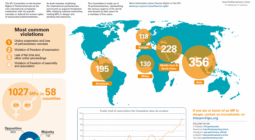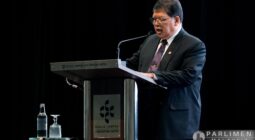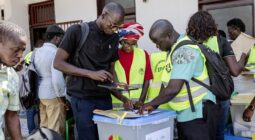

Delegation to Mongolia learn about the development and traditions of the country
A delegation to Mongolia consisting of myself, Rt Hon Baroness Northover, Tan Dhesi MP, Phil Brickell MP, James Wild MP, Lord Cromwell, Dominique Rees MBE (BGIPU Staff) and Joe Perry (BGIPU Staff) flew from London via Istanbul on Saturday 21st June, arriving in Ulaanbaatar at 07.20 on Sunday 22nd. After transferring to the hotel, the delegation was able to rest and recover from the long overnight flight before meeting in the early afternoon for a visit to the Chinggis Khaan National Museum in Ulaanbaatar.
The programme began in earnest on Monday morning with a meeting at the British Embassy with Ambassador Fiona Blyth as well as other Embassy staff. The Embassy held a lunch at the Residence for the delegation with the country head of Rio Tinto, the largest foreign investor in Mongolia which is responsible for almost half of the country’s Foreign Direct Investment (FDI). It was a helpful introduction to our visit. Following lunch, we met with the Director of the Institute for Strategic Studies of Mongolia and then went to the UN House in Ulaanbaatar to meet Evariste Kouassi-Komlan, the Acting Permanent Representative of the United Nations and UNICEF in Mongolia. Whilst we were meeting him and his staff in their ger, the heavens opened during a dramatic and untypical thunderstorm.
On Tuesday 24th June, we spent most of the day in the State Palace visiting the Unicameral Parliament – the State Great Hural. We met the Chair of the Mongolia-UK parliamentary group; the Chair of the Standing Committee on Innovation and Digital Policy; the Chairman (Speaker) of the State Great Hural; the Minister of the Environment and Climate Change; Chair of the Civic Will and Green Party; and one of the Executive Members of the National Coalition Party. In the evening we were hosted for dinner by the Chair of the Standing Committee on Economic Policy. As there has recently been a change of government in Mongolia, many of the Parliamentarians we met had just been appointed to Ministerial positions.
The following day – Wednesday – started with a Roundtable discussion to honour the International Day of Parliamentarianism together with colleagues from the State Great Hural, including Deputy Chair Mrs Bulgantuya – a colleague we had met before at IPU Assemblies – and representatives of the IPU itself who had arrived from Geneva.
After an exciting visit to the Bank of Mongolia’s Treasure Room and its Bank Note exhibition, we were welcomed to lunch at the Bank by its senior management.
The next meeting was with almost the entire Board of the Independent Authority Against Corruption at their headquarters. It’s Director and Chief Commissioner, Mr Dashdavaa, led the meeting answering almost all of the delegation’s searching questions comprehensively. From there we drove to a hotel on the outskirts of the city to meet the Mayor of Ulaanbaatar, Mr Nyambaatar. His staff gave an impressive presentation about the planned Metro system for the city, which is desperately in need of a decent and rapid public transport network given the traffic and pollution problems it has to deal with.
On Thursday we were able to visit the suburban “ger” district which surrounds the capital and has many poorer families living in gers which are mostly currently heated by burning coal. Winter in Mongolia often sees temperatures fall as low as minus 40 degrees centigrade but the coal burning causes not only serious smog but also huge public health problems for the local population. The URECA project (see separate account) aims to replace coal burning with solar energy and battery storage for electric heating and cooking. It was an example of a very exciting innovation which has the power to transform the lives of some of the poorest communities, as well as the air quality of the whole city.
We also had the opportunity to visit the Gandantegchinlen Tibetan Buddhist Monastery on Thursday afternoon, which was a real window into the culture, heritage and religion of the people of Mongolia. We had a tour of the Monastery complex in the heart of Ulaanbaatar and tea with the Deputy Head of the Temple complex – it was truly enlightening.
Finally, on our last day – Friday – we left Ulaanbaatar in three Land Cruisers for the Hustai National Park. The journey was a mixture of on and off road travel and when we arrived we were greeted by the Head of the park who gave us an introduction to the history of Przewalski’s Horses, the wild horses saved from extinction earlier last century who now roam free in the park. After lunch we were able to observe the horses ourselves through binoculars grazing in the distance over the vast open landscape that makes up most of rural Mongolia.
Our final event was a ‘barbecue’ with a Nomadic family about an hour’s drive across the plain from the park and through a river. The family had slaughtered a sheep in our honour and we were greeted with a huge banquet on our arrival at their ger. It was an extraordinary and privileged end to an outstanding visit to a country very few Western Europeans have ever seen. We gained a real sense of the life of nomadic families and the traditions of a people going back hundreds of years.
Mongolia is one of the largest landlocked but most sparsely populated countries in the world with just 3.4 million citizens in a territory six times larger than the UK. Our thanks go to our staff, Dominique and Joe, for their hard work in setting up and running such complex visit; to Batbold, the State Great Hural’s External Relations Officer for his support, knowledge and friendship; to the Mongolian Ambassador in London and the UK Ambassador in Ulaanbaatar; and finally to our former Parliamentary colleague, John Grogan, who must be the best known Briton in Mongolia and who has had the privilege of visiting the country more than fifty times.
















